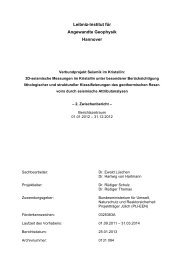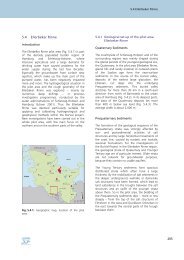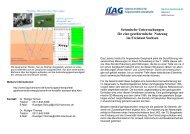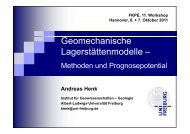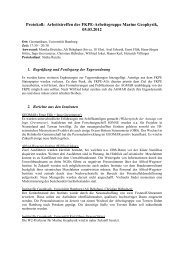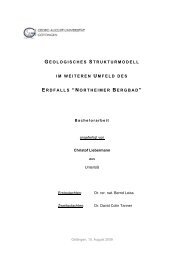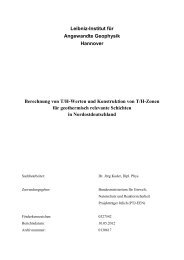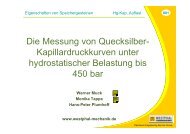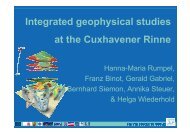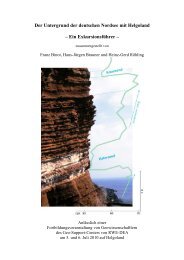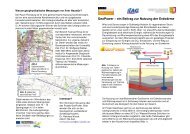4.5 Geoelectrical methods - LIAG
4.5 Geoelectrical methods - LIAG
4.5 Geoelectrical methods - LIAG
You also want an ePaper? Increase the reach of your titles
YUMPU automatically turns print PDFs into web optimized ePapers that Google loves.
82<br />
INGELISE MØLLER, KURT I. SØRENSEN & ESBEN AUKEN<br />
Fig. <strong>4.5</strong>.6: CVES data collected in gradient arrays are shown (a) as curves for each individual array and (b) as a<br />
data pseudo section. Hot colours indicate high resistivities while green and blue colours indicate low resistivities.<br />
system is used in sedimentary environments with<br />
relatively smooth lateral resistivity variations, a<br />
layered inversion model is desirable.<br />
The 1D-LCI solves a number of 1D problems<br />
simultaneously with constraints between<br />
neighbouring models (Auken et al. 2005). This<br />
requires that all separate 1D models have the<br />
same subset of model parameters. The 1D-LCI<br />
approach is illustrated in Figure <strong>4.5</strong>.7. The CVES<br />
dataset in Figure <strong>4.5</strong>.7a is divided into soundings<br />
and models. All models and corresponding<br />
datasets are inverted simultaneously, minimizing<br />
a common object function (Auken & Christiansen<br />
2004). The lateral constraints and constraints<br />
from a priori information are all part of the data<br />
vector together with the apparent resistivity data.<br />
Due to the lateral constraints, information from<br />
one model will spread to neighbour models. If<br />
the model parameters of a specific model are<br />
better resolved, due to, e.g., a priori information,<br />
this information will also spread to neighbour<br />
models.<br />
The lateral constraints can be considered as a<br />
priori information on the geological variability<br />
within the area, where the measurements are<br />
taken. The smaller the expected variation for a<br />
model parameter is, the harder the constraint.<br />
A priori information can be added to the dataset<br />
as depth to layers or layer resistivities. The<br />
information originates from auger– and coredrillings<br />
or geophysical well logs. If the a priori<br />
data agree with the resistivity data, the depth to<br />
layers in the resistivity model will coincide with



